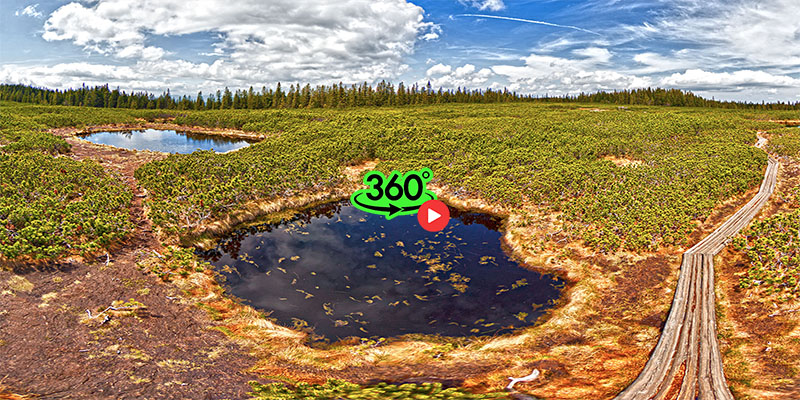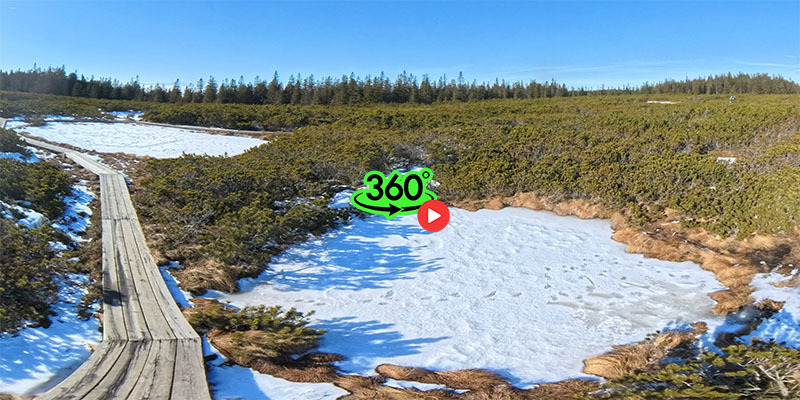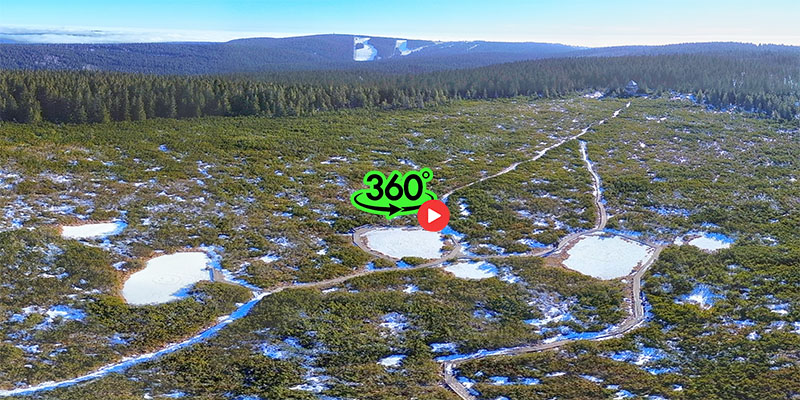The Lovrenška Lakes, also known as the Lovrenška Barje (high bog), are a unique natural phenomenon located in Pohorje, one of the most recognizable and valued natural areas in Slovenia. The Lovrenška Lakes represent one of the best-preserved high bogs in the country, and are an important part of Slovenia's natural heritage and a rich ecological and geomorphological attraction.
The Lovrenška Lakes are located at an altitude of between 1,520 and 1,535 meters above sea level, between the peaks of Mulejev vrh (1,537 m) and Ribniški vrh (1,537 m). The bog covers an area of approximately 22 hectares and consists of 20 to 22 smaller lakes. The lakes are interconnected by peat beds, which are typical of high bogs. The surface area of the lakes varies depending on the amount of precipitation and the season.
The Lovrenška Lakes have exceptional ecological importance, as they represent a habitat for numerous rare and endangered plant and animal species. The water in the lakes is acidic and poor in nutrients, which creates special living conditions. Among the most characteristic plant species are peat mosses (Sphagnum), sundews (Drosera rotundifolia), mosses and grasses such as heather (Calluna vulgaris). Among the animal species, various species of birds, reptiles and insects stand out, which are adapted to these specific conditions.

Lovrenško barje is an example of a high bog, which means that they depend mainly on precipitation and not on groundwater. High bogs are extremely rare and important due to their ecological value and biodiversity. High bogs are characterized by the fact that the peat is very acidic and contains few nutrients. Lovrenško barje is one of the most famous high bogs in Slovenia, but they can also be found elsewhere in the country.
In Slovenia, high bogs are also found in Pokljuka, in the Triglav National Park, and in the area of Črni vrh above Idrija. Raised bogs are an important part of natural heritage also abroad. Some of the most famous raised bogs are located in Sweden (e.g. Store Mosse), Finland (e.g. Patvinsuo) and Canada (e.g. Hudson's Bay Lowlands). These areas are also important for their ecological and geomorphological value and rich biodiversity.
Remnants of the former high bog are also visible today in the Ljubljana Marsh, mostly as birch and Scots pine forests. Before they were drained, they were the southernmost and lowest raised bog in Central Europe.

The bog was formed during the last ice age, when natural basins formed in this area, in which water was retained due to melting ice. The gradual accumulation of organic material, mainly peat moss, led to the formation of peatlands. The process of peat formation is very slow, as it takes several thousand years to form a layer of peat several meters thick.
Lovrenško barje is a popular destination for nature lovers, hikers and photographers. The area is landscaped with wooden paths and viewpoints, which allows for safe and sustainable exploration of natural beauty. Visitors can enjoy peace and quiet, observe rare plant and animal species, and relax in the embrace of unspoiled nature.
The Lovrenška Lakes represent an exceptional natural pearl of Pohorje, which is worth preserving and protecting. Their ecological, geomorphological, and tourist importance is invaluable, as they contribute to biodiversity and sustainable development of the region.

Sources and literature:
1. Maruša Rupel, "Natural Phenomena of Slovenia," Narava Publishing House, 2019.
2. Janez Novak, "Pohorje: Natural Heritage and Tourist Guide," Tourist Association of Slovenia, 2021.
3. Official Portal of Slovenia - [Lovrenška Lakes](https://www.slovenia.si/pohorje-lovrenska-jezera)
4. Encyclopedia of Slovenia, Volume 8, Mladinska knjiga, 1998.
Kutnar, L. (2000). "Spruce Mire Types on the Pokljuka Plateau, Slovenia." Phyton (Horn, Austria) 40 (4): 123-128. This research deals with different types of peat forests on Pokljuka and their vegetation characteristics.
Krivograd Klemenčič, A., Vrhovšek, D., Smolar-Žvanut, N. (2006). "Contribution on the Algal Flora of Slovenia, with Emphasis on Newly Recorded Algal Taxa." Acta Musei Nationalis Pragae, Series B, Historia Naturalis, 62 (1–2): 71–80. This article focuses on phytoplankton and algae in Slovenia, including newly recorded species. Kocjan, J. M., Vreš, B., Seliškar, A., Anderle, B., Dakskobljer, I. (2014). "Contribution to the knowledge of the distribution of plant species of floodplains and marshes in Slovenia – III." Folia Biologica et Geologica 55/2: 75–124. This research deals with the distribution of endangered plant species in Slovenia. |